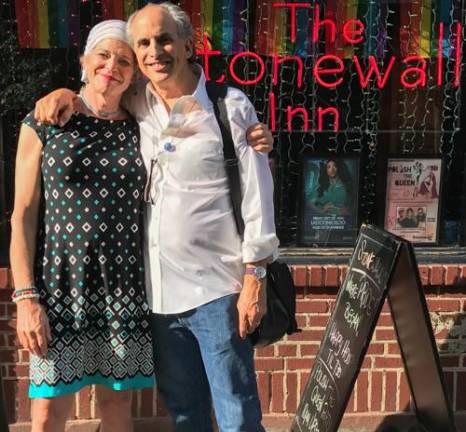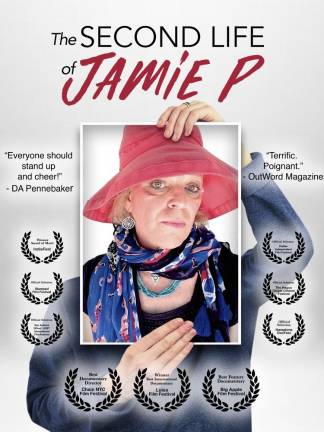A ‘Rollercoaster Journey’
Documentary filmmaker Roger Sherman chronicles the transitioning of a longtime friend


“I think “The Second Life of Jamie P” is the most important film I’ve ever made,” said Roger Sherman, who’s earned two Oscar nods, an Emmy, Peabody and James Beard Award throughout his over four-decade-long career. “And I have made films about divorce, the military, and the environment.”
When Sherman’s friend for over 40 years, Jamie Peebles, told him that she had always been a woman, but only realized it at 63 years old, the Midtown East-based filmmaker admittedly did not know much about the transgender world. What he learned through the making of this documentary, he hopes will enable others to empathize with the suffering and rejoice in the liberation that Jamie experiences while transitioning.
The audience is invited into Jamie’s home, where she smiles as she dresses in feminine clothing and applies makeup, and her car, as she nervously drives to doctor appointments for painful procedures such as breast augmentation surgery and electrolysis for facial hair removal. Sherman even takes his camera into the operating room as she undergoes gender confirmation surgery.
Filled with poignant and raw interviews with Jamie’s daughters, ex-wife, and new love interest, the docufilm shows the effects transitioning has on those around her, but most importantly, Jamie herself.
You were the producer, director and cinematographer of the film. What are some challenges you faced in making it?
We are four hours apart, driving, so I couldn’t be there for every moment. Jamie’s a super tech and was a brilliant television engineer, filmmaker, photographer and college professor, so has about four GoPros, those little cameras. So I said, “Whenever something important happens in your life, do a video diary.” She ended up putting a GoPro in her car; she was most comfortable talking to viewers there. She would call me after something happened that was not fun, like maybe she had a telephone call and the person kept calling her, “Sir,” even after she said, “Excuse me, I’m a woman.” And she would call me in tears and I would do everything I could to be there for her. Then I had to put my director’s cap on and say, “While it’s still raw, you need to go out to your car and tell us about what just happened.” And most of the time, she did.
One of Jamie’s daughters, Tina, said, “My dad is gone.” Tell us about the girls’ reactions.
Tina and her, at that time, fiancé Nick, lived with Jamie, so they were all in this maelstrom together. I went up and hung out for a couple of days and got to know Tina. My expertise is getting people to open up to me and to trust me, and she did. She was very open and clear about the issues between she and her father and how she was having trouble dealing with them. She worked a lot in theater, so is very much in the gay community. One of her closest friends, who’s gay, introduced her to her future husband. So this is not a foreign thing for her; she has trans friends. But when it came to her father, she completely lost it, as you saw in the film. She became a puddle on the floor. And Jamie called up his ex-wife and said, “You gotta come up here.” Angie, who is on the spectrum, had a much easier time. She was just angry at her dad for telling her that she was transitioning by text, as you saw in the film. And that really shows what kind of state Jamie was in. This is an incredibly smart, introspective person who texts her daughter that she’s transitioning.
As for Jamie’s ex-wife Elaine, at one point in the film, she said, “I wouldn’t wish it on anybody.” How did she cope with the ordeal?
I was surprised at how well she was handling it. She was able to use the female pronouns, as many people are not able to do when they know somebody as the other sex before. I had that problem for a while, calling Jamie, “he,” and Jamie was very nice about it and would gently correct me. They would go do girl things, like shopping, and that was not completely comfortable for Elaine, she said to me privately. But she obviously saw that it was a way to get back in a relationship with Jamie that was very important because of the children. They had not been close for quite some time since their divorce. She did immediately come up to Massachusetts when Jamie told her what happened with Tina. She was a hero; she saw the pain Tina was going through and realized that she had to act and be there even though she and Jamie were divorced and barely speaking, and she did that in spades.
What is a misconception Jamie wants to dispel?
Jamie says that quite often when she meets people, they say, “You’re so brave.” And she says, “I am not brave. This was a life and death decision. It was either transition, which I did not want to do, or jump in front of a train.” Which happens, too frequently. This year is the highest number of killings of transgender people ever. Twenty transgender people have already been killed this year.
You filmed Jamie’s gender confirmation surgery. What was that like?
Dr. Marci Bowers was incredibly generous, and is narrating what’s going on while she’s doing the surgery. She’s world renowned and has done thousands of these and happens to be transgender. She’s very eager to spread the word and tells us it’s not an amputation, everything is repurposed, as evidenced a month later, when Jamie has her first orgasm as a woman. I had never filmed in an operating room in my life, but knew this was a very important scene and I just needed to do it. There were not even moments of me feeling queasy and I saw everything. The challenge for me as a filmmaker was what do I want to show you, the audience? How am I going to bring you along on this rollercoaster journey? I thought, even before I went into the operating room, that I had to show the surgery without actually showing the surgery.
The Second Life of Jamie P is now streaming on YouTube, Amazon, GooglePlay and Apple TV.
To watch the film’s trailer and learn more about Roger, visit www.florentinefilms.com/sherman/project/the-second-life-of-jamie-p